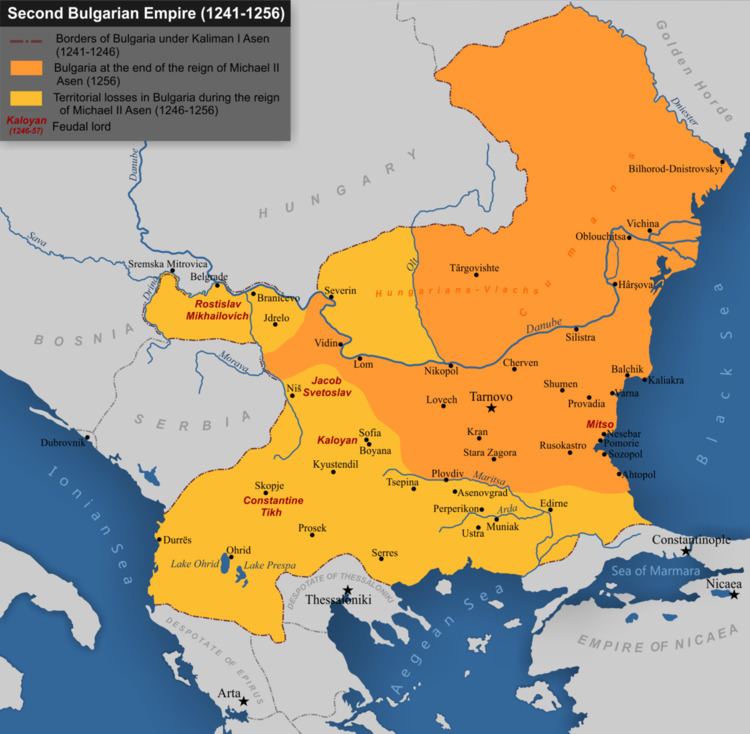Reign 1241–1246 Name Kaliman of | Predecessor Ivan Asen II | |
 | ||
Father Ivan Asen II of Bulgaria Successor Michael Asen I of Bulgaria Parents Anna Maria of Hungary, Ivan Asen II of Bulgaria Grandparents Andrew II of Hungary, Ivan Asen I of Bulgaria, Gertrude of Merania, Elena-Evgenia, wife of Ivan Asen I Great-grandparents Bela III of Hungary, Agnes of Antioch, Agnes of Rochlitz, Berthold, Duke of Merania Similar People Ivan Asen II of Bulgaria, Theodore Komnenos Doukas, Andrew II of Hungary | ||
Kaliman Asen I, also known as Coloman Asen I or Koloman (Bulgarian: Калиман Асен I; 1234–August/September 1246) was emperor (or tsar) of Bulgaria from 1241 to 1246. He was the son of Ivan Asen II of Bulgaria and Anna Maria of Hungary. He was only seven when he succeeded his father in 1241. In the following years, the Mongols invaded Bulgaria and imposed a yearly tax on the country. He may have been poisoned, according to contemporaneous rumors about his death.
Contents
Early life
Kaliman was the son of Ivan Asen II of Bulgaria and Anna Maria of Hungary. He was born in 1234. His mother died before 1237, when his widowed father married Irene Komnene Doukaina. Ivan Asen also died in the first half of 1241.
Reign
Kaliman was only seven when he succeeded his father. Although no primary sources provide information about the government of the country during the minor monarch's reign, Bulgaria was obviously ruled by one or more regents. Historian Alexandru Madgearu proposes that Ivan Asen's brother, Alexander, was most probably the sole regent for Kaliman; other scholars say, a regency council was established under the leadership of Patriarch Joachim I. Bulgaria, the Latin Empire and the Empire of Nicaea signed a truce for two years shortly after Kaliman Asen's ascension.
Two contemporaneous clergymen, Roger of Torre Maggiore and Thomas the Archdeacon, recorded that Kadan (a son of Ögödei, Great Khan of the Mongols) broke into Bulgaria in March 1242. Thomas also mentioned that Kadan and Batu Khan "resolved to hold a muster of their military forces" in Bulgaria. More than 60 years later, Rashid-al-Din Hamadani also knew that "after much fighting" Kadan captured two towns in "Ulaqut" (or Bulgaria). Archaeological evidence shows that at least a dozen Bulgarian fortresses (including Tarnovo, Preslav and Isaccea) were destroyed during the Mongol invasion. Although the country was not occupied, the Bulgarians were to pay a tribute to the Mongols thereafter.
Pope Innocent IV convoked a synod at Lyon to establish a coalition against the Mongols in 1245. He also sent a letter to Kaliman, urging him to bring the Bulgarian Orthodox Church into a full communion with the Holy See and to send delegates to Lyon. Kaliman was only twelve when he died in August or September 1246. The contemporary Byzantine historian George Akropolites, recorded that contradictory rumours spread about Kaliman's death. Some said that "he had succumbed to a natural illness"; others claimed that "he was killed by a draught secretly prepared to cause his death by those who were of contrary opinion to him". Patriarch Vissarion also died in September 1246. Madgearu says, this coincidence implies that both were murdered by those who opposed the Church union, according to Madgearu. According to a 14th-century charter, Kaliman Asan was the ruler of "Moldo-Wallachia" (or Moldavia), but the document is a late forgery. The northern border of Bulgaria did not expand over the Lower Danube.
